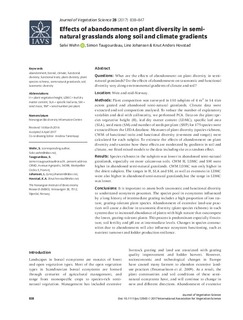| dc.contributor.author | Wehn, Sølvi | |
| dc.contributor.author | Taugourdeau, Simon | |
| dc.contributor.author | Johansen, Line | |
| dc.contributor.author | Hovstad, Knut | |
| dc.date.accessioned | 2017-12-18T12:35:37Z | |
| dc.date.available | 2017-12-18T12:35:37Z | |
| dc.date.created | 2017-06-14T13:22:43Z | |
| dc.date.issued | 2017-05-25 | |
| dc.identifier.citation | Wehn, S., Taugourdeau, S., Johansen, L. and Hovstad, K. A. (2017), Effects of abandonment on plant diversity in semi-natural grasslands along soil and climate gradients. J Veg Sci, 28: 838–847. | nb_NO |
| dc.identifier.issn | 1100-9233 | |
| dc.identifier.uri | http://hdl.handle.net/11250/2472476 | |
| dc.description.abstract | Questions: What are the effects of abandonment on plant diversity in seminatural
grasslands? Do the effects of abandonment on taxonomic and functional
diversity vary along environmental gradients of climate and soil?
Location: West and mid-Norway.
Methods: Plant composition was surveyed in 110 subplots of 4 m2 in 14 sites
across grazed and abandoned semi-natural grasslands. Climate data were
extracted and soil composition analysed. To reduce the number of explanatory
variables and deal with collinearity, we performed PCA. Data on the plant species
vegetative height (H), leaf dry matter content (LDMC), specific leaf area
(SLA), seed mass (SM) and number of seeds per plant (SNP) for 175 species were
extracted from the LEDA database. Measures of plant diversity (species richness,
CWM of functional traits and functional diversity (evenness and range)) were
calculated for each subplot. To estimate the effects of abandonment on plant
diversity and examine how these effects are moderated by gradients in soil and
climate, we fitted mixed models to the data including site as a random effect.
Results: Species richness in the subplots was lower in abandoned semi-natural
grasslands, especially on more calcareous soils. CWM H, LDMC and SM were
higher in abandoned semi-natural grasslands. CWM LDMC was only higher in
the driest subplots. The ranges in H, SLA and SM, as well as evenness in LDMC
were also higher in abandoned semi-natural grasslands,but the range in LDMC
was lower.
Conclusions: It is important to assess both taxonomic and functional diversity
to understand ecosystem processes. The species pool in ecosystems influenced
by a long history of intermediate grazing includes a high proportion of low stature,
grazing-tolerant plant species. Abandonment of extensive land-use practices
will cause a decline in taxonomic diversity (plant species richness) in such
systems due to increased abundance of plants with high stature that outcompete
the lower, grazing-tolerant plants. This process is predominant especially if moisture,
soil fertility and pH are at intermediate levels. Changes in species communities
due to abandonment will also influence ecosystem functioning, such as
nutrient turnover and fodder production resilience. | nb_NO |
| dc.language.iso | eng | nb_NO |
| dc.publisher | John Wiley and Sons | nb_NO |
| dc.rights | Navngivelse-Ikkekommersiell 4.0 Internasjonal | * |
| dc.rights.uri | http://creativecommons.org/licenses/by-nc/4.0/deed.no | * |
| dc.title | Effects of abandonment on plant diversity in seminatural grasslands along soil and climate gradients | nb_NO |
| dc.type | Journal article | nb_NO |
| dc.type | Peer reviewed | nb_NO |
| dc.description.version | publishedVersion | nb_NO |
| dc.rights.holder | © 2017 International Association for Vegetation Science | nb_NO |
| dc.source.pagenumber | 838–847 | nb_NO |
| dc.source.volume | 28 | nb_NO |
| dc.source.journal | Journal of Vegetation Science | nb_NO |
| dc.identifier.doi | http://dx.doi.org/10.1111/jvs.12543 | |
| dc.identifier.cristin | 1476034 | |
| dc.relation.project | Norges forskningsråd: 208036 | nb_NO |
| cristin.ispublished | true | |
| cristin.fulltext | original | |
| cristin.qualitycode | 1 | |

